
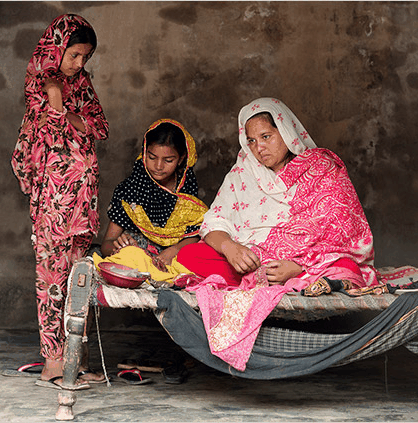 The issue of forced marriages and domestic violence clearly struck a chord with many of the TLH readers. But somewhere deep in the comments over titles, or whether these are Sikh or Punjabi issues, or whether or not we should air our “dirty laundry” in the first place – I feel some of the issues themselves got lost. In formulating my own thoughts on the topic and trying to build a broader perspective on women’s issues in general, I came across a fascinating article in last week’s New York Times Magazine called “Saving the World’s Women.” The premise of the article is that many of the countries that are disproportionately poverty-stricken and absorbed in fundamentalism and chaos, are also those same countries where women are the least educated and most marginalized. And by focusing (and investing) on women and girls, a dramatic impact can be made to fight global poverty and extremism.
The issue of forced marriages and domestic violence clearly struck a chord with many of the TLH readers. But somewhere deep in the comments over titles, or whether these are Sikh or Punjabi issues, or whether or not we should air our “dirty laundry” in the first place – I feel some of the issues themselves got lost. In formulating my own thoughts on the topic and trying to build a broader perspective on women’s issues in general, I came across a fascinating article in last week’s New York Times Magazine called “Saving the World’s Women.” The premise of the article is that many of the countries that are disproportionately poverty-stricken and absorbed in fundamentalism and chaos, are also those same countries where women are the least educated and most marginalized. And by focusing (and investing) on women and girls, a dramatic impact can be made to fight global poverty and extremism.
Take the example of Saima Muhammad (pictured above) from Pakistan. Saima didn’t have a rupee to her name, was routinely beaten by her unemployed husband and other family members, and had to send her kids away due to lack of food and other basics. Even her mother-in-law contributed to her troubles by encouraging her son to marry again because Saima was only giving birth to girls. However, after Saima signed up with the Kashf Foundation, a Pakistani microfinance organization, things turned around.
Saima took out a $65 loan and used the money to buy beads and cloth, which she transformed into beautiful embroidery that she then sold to merchants in the markets of Lahore. She used the profit to buy more beads and cloth, and soon she had an embroidery business and was earning a solid income — the only one in her household to do so. Saima took her elder daughter back from the aunt and began paying off her husband’s debt.
…Saima became the tycoon of the neighborhood, and she was able to pay off her husband’s entire debt, keep her daughters in school, renovate the house, connect running water and buy a television.
As the economics of Saima’s situation changed, so did the relationship with her family. She now has a better relationship with her family and has earned their respect. It is unfortunate that this is what it took for Saima, and many will never have the golden opportunity Saima had, but it does send a clear message – that although it may seem impossible to break down cultural barriers, economics can change the game quickly.
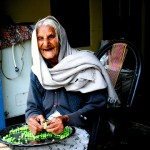 Often times the elderly are considered “high-cost” because they take money out of American system. They are seen as a “liability” because they withdraw medicare and social security benefits. Foriegn elders are similarly viewed as a group that “takes” through government benefits, but is not expected to serve the American system for very long.
Often times the elderly are considered “high-cost” because they take money out of American system. They are seen as a “liability” because they withdraw medicare and social security benefits. Foriegn elders are similarly viewed as a group that “takes” through government benefits, but is not expected to serve the American system for very long.
However, in a recent study at the Center for Intergenerational Learning at Temple University, scholars found that “older immigrants are not inert drains in the U.S. system but an invisible force of community contributors in the United States”.
The study found that immigrant elders contribute to community cohesion by playing leadership roles in families. Also, their sense of interconnectness, rooted in religious and cultural values, forces them to look out for the collective good. They are also a good source for motivating the younger generation to support community members.
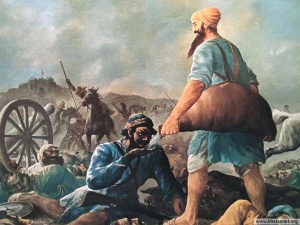 I’ve always enjoyed a good story…and amongst all the depressing news lately of our declining economy, raucous town hall meetings, and corrupt politicians…I often turn to StoryCorp’s podcasts for a quick “pick-me-up”. A few months back, I came across a beautiful piece titled “Finding El Dorado.” It’s the story of Gus Hernandez and the unique friendship he developed with Siddiqi Hansoti as a result of the current economic crisis. I was moved by this simple story of compassion and the power of the human spirit. Take a listen…it’s only 3 minutes [link].
I’ve always enjoyed a good story…and amongst all the depressing news lately of our declining economy, raucous town hall meetings, and corrupt politicians…I often turn to StoryCorp’s podcasts for a quick “pick-me-up”. A few months back, I came across a beautiful piece titled “Finding El Dorado.” It’s the story of Gus Hernandez and the unique friendship he developed with Siddiqi Hansoti as a result of the current economic crisis. I was moved by this simple story of compassion and the power of the human spirit. Take a listen…it’s only 3 minutes [link].
This story got me thinking about compassion and what it means to a Sikh. After some brief research, I found dozens of references to Daya (and its variations – Dayal, Dayala etc.) in the Sri Guru Granth Sahib Ji. Depending on the context, it is loosely translated as compassion, mercy or pity. Several times it is used as an attribute of Waheguru:
miharavaan kirapaal dhaeiaalaa sagalae thripath aghaaeae jeeo |3|
He is Merciful, Kind and Compassionate. All are satisfied and fulfilled through Him. ||3||
Other times it is used in the context of an Ardaas:
jath sath chaaval dhaeiaa kanak kar praapath paathee dhaan |
Please bless me with the rice of truth and self-restraint, the wheat of compassion, and the leaf of meditation.
But what I connected with the most was how compassion was described as a necessary attribute of the GurSikh:
dhaeiaa kapaah santhokh sooth jath gantee sath vatt |
Make compassion the cotton, contentment the thread, modesty the knot and truth the twist.
eaehu janaeoo jeea kaa hee th paaddae ghath |
This is the sacred thread of the soul; if you have it, then go ahead and put it on me.
Blogged by: sikhpulse
The Christian community is confronting the development of the “Sixth American:” those individuals who do not exist in or identify with any particular space and ultimately congregate together. These integrated congregations are hopeful signs that the elements of discrimination and racism which infiltrated most churches over the last two centuries are slowly being eradicated.
Strangely enough, Sikh-Americans aren’t evolving in the same direction. In less than fifty years, Sikh-Americans have (get this) provided an anti-model for our adopted culture by dividing into self-identifying congregations, sects and denominations!
This may in part be explained by our natural connection to our social networks. Like members of other faiths, we choose to go to a place of worship that is attended by our families. We go where our friends attend. We go where our language is spoken. We are segregated by whether we are brand-spankin-new-citizens or third-generation Sikh Americans. We are separated by our interests and our jobs.
Blogged by: Amol Singh
A new generation of Sikh youth is coming up to age in a diaspora still unable to decently reflect or respond to the tragedies that have befallen the Panth. Although, cognizant of the injustices done to Sikhs, we have categorically failed at identifying a half-way legitimate vision for our institutions.The following is a humble attempt at one such institution, hinted at by an older post.
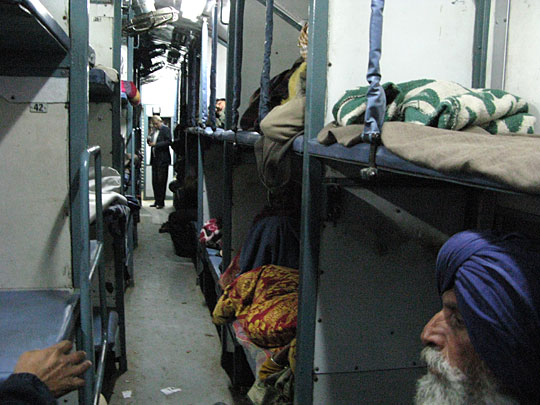
Much of Punjab’s money flow is due to remittances from family members scattered across the globe. However, remittances are easily subjected to ebb and flows in the world’s markets and these flows of money to Punjab can be easily disrupted by economic downturns. In addition, Punjab receives little attention from international development agencies. For instance, there are currently a total of two World Bank projects targeting the state. Unfortunately, Punjab is receiving more attention from MNC’s and the introduction of SEZ’s inside the state is unnerving to many who believe that they foreshadow an increase in neoliberal market practices favoring large corporations.
In my opinion, Punjab needs an insertion of human and financial capital that can ignite a grassroots based economic revival that quantifies development on the creation of ecologically friendly infrastructure. To being the process for these goals, I propose the creation of a development bank.
 Gatka is becoming popular amongst Sikhs and non-Sikhs in the West. Raveena writes that this resurgence in the Toronto area is primarily because of The Annual International Yudh Gatka Tournament that originated in Toronto in 2003. This year the tournament is being held in New Jersey. The Toronto leg of the tournament will on August 23rd the Rexdale Gurdwara Sahib. You can find out more information at Yudh.net.
Gatka is becoming popular amongst Sikhs and non-Sikhs in the West. Raveena writes that this resurgence in the Toronto area is primarily because of The Annual International Yudh Gatka Tournament that originated in Toronto in 2003. This year the tournament is being held in New Jersey. The Toronto leg of the tournament will on August 23rd the Rexdale Gurdwara Sahib. You can find out more information at Yudh.net.
Why is Gatka becoming so popular? Yudh.net writes that, “Not only does Gatka emphasize the physical training of martial arts, but it puts a special focus on ‘mental’ training which is needed to be successful in any sport”. Thus, this traditional Sikh martial arts from the early 17th century is a place to relieve stress, heighten awareness, but also learn sportsmanship and respect-for both people and weapons.
For those of you who attend the Tournament, please let us know how it goes.
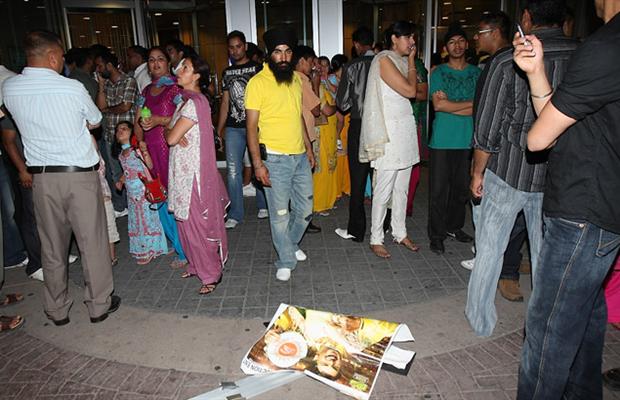 For diasporic Sikhs, it seems routine and almost expected to wake up to news about an incident where a Sikh was banned access to an event because of his or her kirpan. Many times, we blame this on the ignorance of law enforcement, who often have never heard of a kirpan. We tell ourselves, “Don’t worry, we just have to teach them and they’ll understand.” However, when Kirpan wearing patrons at a Gurdas Mann concert are barred entry, then we must stop for pause.
For diasporic Sikhs, it seems routine and almost expected to wake up to news about an incident where a Sikh was banned access to an event because of his or her kirpan. Many times, we blame this on the ignorance of law enforcement, who often have never heard of a kirpan. We tell ourselves, “Don’t worry, we just have to teach them and they’ll understand.” However, when Kirpan wearing patrons at a Gurdas Mann concert are barred entry, then we must stop for pause.
When a kirpan wearing citizen is blocked access from exercising their civil liberties, we as a community go into uproar mode. We file lawsuits, organize protests, and launch mass public marketing campaigns in order to exercise what we believe to an unalienable right and an articulation of our personal sovereignty. When a Bollywood movie comes out with a Sikh hero sans beard, our institutional bodies outrun and out-leap each other to be the first to cry foul. When a Baba in a Dera dresses up as Guru Gobind Singh Ji, we bring the state of Punjab to a halt.
However, at the point where cultural icon and repository Gurdas Mann, goes so far as to write “No Kirpans or Sharp Objects Allowed” on tickets being sold at a VAISAKHI show in England, then what do we do? We let him carry forward and WE outrun and out-leap each other so we can be first in line at his next concert.
Now when his concert bans an entity which is legally allowed in the public spaces of Canada, then what do we do? Do we ignore and slowly sweep this incident under the rug, like so many of our cultural problems? Or, do we stop and say, Hey, standing next to K.P.S Gill and lambasting “Sikh terrorism” is not ok; banning kirpans in UK is not appreciated; and throwing out concertgoers in Alberta, is simply no longer going to work.
One of the three Khalsa schools in Vancouver burnt to the ground yesterday. Arson is suspected. The fire started in 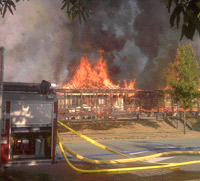 the main building and two portable classroom buildings simultaneously, and spread rapidly. The Elementary School had been broken into as well. When the school secretary called 911 to report the break-in, she saw smoke coming from one of the schools. The 911 operator told her to get out of the building and that firetrucks were on their way. [Globe and Mail]
the main building and two portable classroom buildings simultaneously, and spread rapidly. The Elementary School had been broken into as well. When the school secretary called 911 to report the break-in, she saw smoke coming from one of the schools. The 911 operator told her to get out of the building and that firetrucks were on their way. [Globe and Mail]
Firefighters brought the fire under control in 90 minutes, but of the 9 buildings that made up the Khalsa school, only one remains. They were able to save the Guru Granth Sahib Ji from the fire, making a touching scene when they carried it out to the sangat.
 I was very impressed to see this great article (and cool pic!) in today’s Daily Mail. Along similar lines as last week’s post on the Blue Beret Kanhaiyas, it is wonderful to see Sikhs presented in this light…as confident and courageous soldiers in highly respected positions. Equally fascinating are some of the comments to the article which seem to be coming from mostly non-Sikhs, such as “Her Majesty is in safe hands with those two guarding her” and “Very smart they look too.” This is a far cry from the hate you’ll find on some of the military websites and blogs regarding the Sikh Coalition’s “Right To Serve” campaign. I hope this milestone and media attention of the Queen’s new guards will help serve as a stepping stone in this historic campaign here in the US.
I was very impressed to see this great article (and cool pic!) in today’s Daily Mail. Along similar lines as last week’s post on the Blue Beret Kanhaiyas, it is wonderful to see Sikhs presented in this light…as confident and courageous soldiers in highly respected positions. Equally fascinating are some of the comments to the article which seem to be coming from mostly non-Sikhs, such as “Her Majesty is in safe hands with those two guarding her” and “Very smart they look too.” This is a far cry from the hate you’ll find on some of the military websites and blogs regarding the Sikh Coalition’s “Right To Serve” campaign. I hope this milestone and media attention of the Queen’s new guards will help serve as a stepping stone in this historic campaign here in the US.
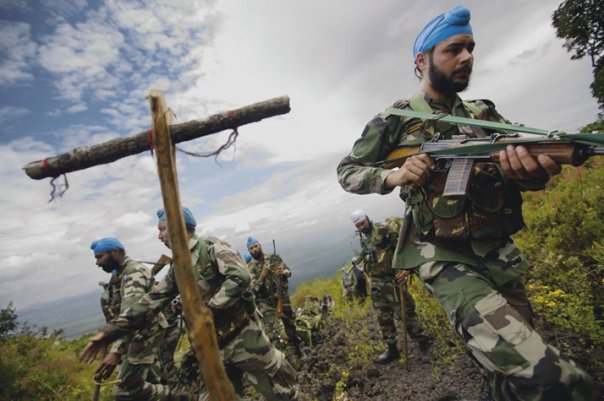
Blogged by: Amol Singh
Virunga National Park lies in Eastern Congo adjacent to Rwanda. Throughout the past fifteen years, the region has been embroiled in communal strife and has become the backdrop for some of the most wanton killings of peoples in recent history. In the battle over the area’s vast natural resources, militias, poachers, and park rangers are in a constant struggle to establish domain over the park and its enormous natural resources. The park initially became famous for its population of increasingly rare Silverback Mountain Gorillas. Although protected internationally, the gorillas (and the rangers sworn to protect them) are powerless against an illicit $30 million natural resources trade involving the pilfering of local charcoal deposits.
In a National Geographic article published last year, journalist Mark Jenkins recounts his trip inside the National Park in search of the Silverbacks. Jenkins and a team of Park Rangers were escorted by a party of Sikh UN Peacekeepers.
We hike in the next morning. Our force numbers almost 50, including 12 rangers and Muir. At its core are 18 Sikhs, all veteran fighters, commanded by Maj. Shalendra Puri. UN soldiers are typically called “blue helmets,” but in this case they are the blue turbans.
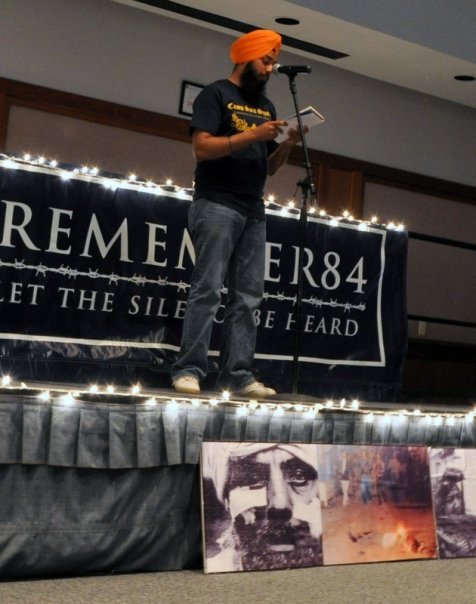 This past Saturday night, twenty artists from all over the country took to the mic in front of a packed and energetic crowd at the University of Maryland for Lahir 2009. It was a powerful evening of remembrance and reflection to commemorate the 25th anniversary of the 1984 Sikh Holocaust, organized by the DC Sikh Youth.
This past Saturday night, twenty artists from all over the country took to the mic in front of a packed and energetic crowd at the University of Maryland for Lahir 2009. It was a powerful evening of remembrance and reflection to commemorate the 25th anniversary of the 1984 Sikh Holocaust, organized by the DC Sikh Youth.
It was amazing to see teenagers, college students, young professionals, and even a few parents take to the stage and share their thoughts and reflections about 1984, human rights, and justice. Not only did the performers span across generations, but the performances themselves ranged in art form from musical pieces, poetry, and spoken word.
For me, it was fascinating to see how different each of the performers connected with 1984 – early in the show one artist eloquently recited an excerpt from Sirdar Kapur Singh’s 1966 speech to parliament, another tied environmental issues and water rights to 1984, while others shared personal accounts, poetry, dharmik geets, and dhadi vaaran. Regardless of how different each artist connected to 1984…the connection itself was strong…and watching that unfold on stage was absolutely breathtaking!
The evening concluded with G.N.E performing some of their recent tracks in front of their hometown audience. Seeing uncles and aunties “waving from side to side” was definitely a sight to remember.
Oregon recently passed a bill to repeal its ban on religious attire in the workplace, a policy adopted 100 years ago as part of anti-Catholic backlash. However, it let stand an exception to this act — specifically, it continues to ban wearing “religious attire” in classrooms. Its decision strikes against its stated policy goal: to ameliorate religious discrimination in the workplace.
Religious affiliation is a protected class under U.S. equal protection (14th Amendment) and Civil Rights law, but it is subject to a much more lenient standard of review than other forms of discrimination (e.g., race). In 1980, the Supreme Court upheld Oregon’s workplace ban. The Legislature supports its ban by claiming that it is designed to avoid proselytization in the classroom. This is both misguided and continues to advance discrimination.
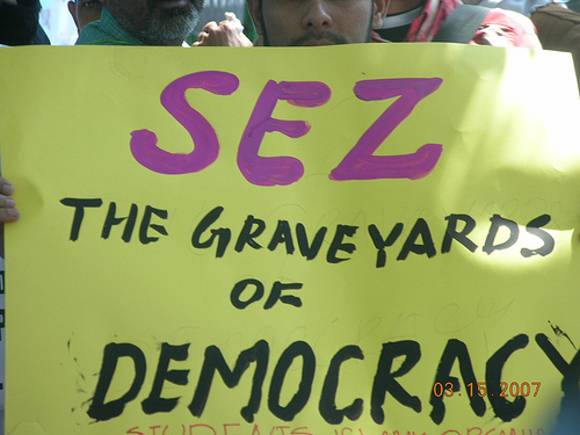 Earlier this month TLH discussed how the unseasonably dry summer in Punjab is threatening its agriculture and economy. This week, the Punjab Assembly adopted a resolution authorizing the development of additional Special Economic Zones, or SEZs, while streamlining and supporting the existence of pre-existing SEZs.
Earlier this month TLH discussed how the unseasonably dry summer in Punjab is threatening its agriculture and economy. This week, the Punjab Assembly adopted a resolution authorizing the development of additional Special Economic Zones, or SEZs, while streamlining and supporting the existence of pre-existing SEZs.
SEZs are not entirely new to Punjab. In 2006, Punjab cleared thirteen (13) SEZs for development and approval, and the proposal was approved by the Indian central government in 2007. The current number of “greenlit” SEZs in Punjab currently totals 12, but the number could increase extensively.
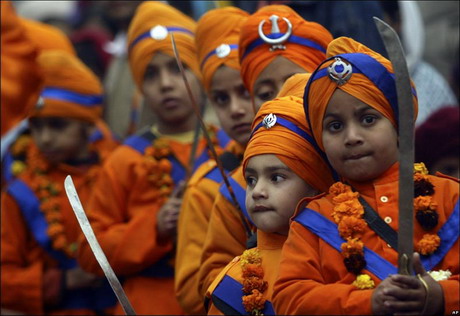 It’s that time of year again…camp time! Sikh youth all over the world are packing their bags and heading out to their favorite Gurmat camp to learn, reflect, and have a blast with their Sangat! I’m very lucky to have been involved in Sikh youth camps for most of my life – as a camper, counselor, and administrator…and boy do I have a few stories to tell! To mark this exciting time, I’d like to share a story I call “Proud To Be Six.”
It’s that time of year again…camp time! Sikh youth all over the world are packing their bags and heading out to their favorite Gurmat camp to learn, reflect, and have a blast with their Sangat! I’m very lucky to have been involved in Sikh youth camps for most of my life – as a camper, counselor, and administrator…and boy do I have a few stories to tell! To mark this exciting time, I’d like to share a story I call “Proud To Be Six.”
I remember the first time I was ever a counselor. I was 18 years old and my first task was to lead an orientation for the youngest kids at camp. After several unsuccessful attempts to a lead a discussion, I went with what I knew…and just did a bunch of jakaray!
The kids were all riled up and having a blast! Then I yelled at the top of my lungs, “Are you proud to be Singhs & Kaurs of the Guru!” They all yelled out “Yeeeaaahhh!” “Are you proud to be Khalsas!” They all yelled out “Yeeeaaahhh!” “Are you proud to be Sikhs!” Silence…
I thought perhaps they didn’t hear me. I said, “Are you proud to be Sikhs!” Still, silence…then all the kids started looking around at each other in confusion.
Then finally, one brave little boy raised his hand and said, “VeerJi, I’m only five.” Quickly, hand after hand went up with kids saying “me too, me too…I’m only four”
After holding in my laughter and finally composing myself, I thought I would try an experiment. Although I had to cringe when I said it, I yelled out:
Are you proud to be Seeeeks! They all yelled out “Yeeeaaahhh!”
 Turbanology, or knowledge of Turbans, is a TV documentary recently released in the UK which explores the meaning of the turban in England since the London bombings. Filmmaker, Jay Singh-Sohal, was working for a conservative think-tank in the US when he first began considering the misconceptions surrounding the turban and the subsequent profiling of individuals and communities. The documentary discusses the origin and importance of the turban in modern Britain to “see whether it’s just harmless headwear or really the fashion of a fantatic”.
Turbanology, or knowledge of Turbans, is a TV documentary recently released in the UK which explores the meaning of the turban in England since the London bombings. Filmmaker, Jay Singh-Sohal, was working for a conservative think-tank in the US when he first began considering the misconceptions surrounding the turban and the subsequent profiling of individuals and communities. The documentary discusses the origin and importance of the turban in modern Britain to “see whether it’s just harmless headwear or really the fashion of a fantatic”.
The film addresses the impact 9/11 and 7/7 has had on the [mis]understanding of the turban as a symbol of fear, hatred and global terrorism. Australian researchers at the University of New South Wales published a study in 2008 which found that simply noticing someone could be a Muslim increased the aggressive tendencies on the part of non-Muslim westerners. They called it the “Turban Effect.” Turbanology seeks to raise awareness of the turban’s importance and discuss why the people who wear it consider it a crown. In the documentary, Jay Singh-Sohal speaks to music producers, politicians and ordinary Sikhs and Muslims who have been affected by wearing a turban. (A preview of the documentary can be seen after the jump).
“The documentary discovers that simply noticing someone could be a Muslim increases the aggressive tendencies of westerners. The give-away sign is the turban, and the beard. Whether conscious or sub-conscious, the fact that terrorism is a worry for many people means that there’s been a rise in profiling who could be a threat – an issue explored in the piece.” [link]
Punjab’s historical economic dominance is well known. We hear about it when studying The Raj and the years following it. However, we also know that Punjab’s current economic position does not provide many new jobs for college graduates. Thus, these graduate are looking for jobs outside of Punjab-often in Western countries. Recently, there was a comparative study by the Economics Department at Punjabi University, Patiala to provide research data for these conclusions. This study “… revealed that Punjab is lagging behind for providing employment to its educated and skilled people in the last two decades”.
“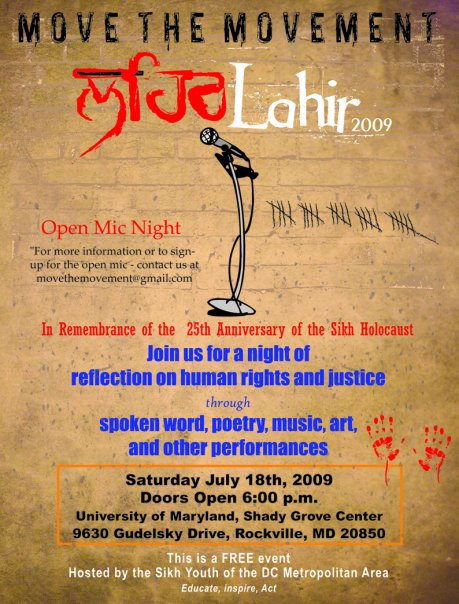 Never doubt that a small group of thoughtful, committed citizens can change the world. Indeed, it is the only thing that ever has.”
Never doubt that a small group of thoughtful, committed citizens can change the world. Indeed, it is the only thing that ever has.”
(Margaret Mead)
Last Summer, a small group of thoughtful, committed Sikh youth from the DC Metropolitan area came together to form “Lahir” (movement) – a conference organized and run by high school and college students to promote human rights awareness. There were three themes to the event. Educate, Inspire, and Act. The “Educate” segment consisted of a series of short presentations outlining the history of post-1984 human rights violations in Punjab, based on published documentation from Ensaaf. These presentations interspersed with videos of the victim’s families told the story of grave violations that occurred between 1984-1995 during the counter-insurgency movement – including torture, disappearances, and illegal cremations. The “Inspire” segment consisted of poetry, spoken word, and musical performances along the same theme. In the final portion, titled “Act”, participants broke out in to discussion groups and brainstormed ideas on how the Punjab case can be raised to a mainstream audience and reviewing what other communities have done to highlight their cause. Overall, the conference was a resounding success and launched several new initiatives.
This Summer, the Lahir team has re-assembled and Sikh youth activists and artists from all over the country will again descend upon the Nation’s Capital for Lahir 2009! This year’s format is an all-out ‘Open Mic’ with musical performances, displayed art, poetry, and spoken word. Trailers have been circulating around the internet, providing a glimpse of what to expect.
Co-blogged by Sundari and Camille.
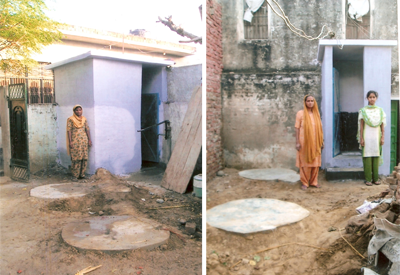 While many LangarHall moments are spent bringing awareness to adverse issues impacting our community, we believe it is equally important to highlight solutions to these problems. There are several people and organizations who are working to improve the social development and health of communities around the world. One example of a simple yet life changing initiative is a toilet. Yes, toilets. A facility taken for granted by many and something that over 2 million people around the world are in need of. The Punjab Lioness Toilet Foundation was created to provide awareness of communities in need of basic toilet and sanitation facilities,
While many LangarHall moments are spent bringing awareness to adverse issues impacting our community, we believe it is equally important to highlight solutions to these problems. There are several people and organizations who are working to improve the social development and health of communities around the world. One example of a simple yet life changing initiative is a toilet. Yes, toilets. A facility taken for granted by many and something that over 2 million people around the world are in need of. The Punjab Lioness Toilet Foundation was created to provide awareness of communities in need of basic toilet and sanitation facilities,
As a family initiative the Punjab Lioness Toilet Foundation wants to empower people to take action in providing basic toilet needs to less fortunate families in Punjab, India. The foundation was started in the memory of our late mother Pritam Kaur Bahia who passed away on November 18th, 2004. She was known as the “Sherni” a.k.a. Lioness. [link]
Founded by Mandip Kaur Sandher, one of the goals of the organization is to break the “toilet taboo,” which comes from people’s lack of comfort speaking about a subject which they consider dirty. This stigma is impacting global health and as a result, basic sanitation needs for hundreds and thousands of people around the world.
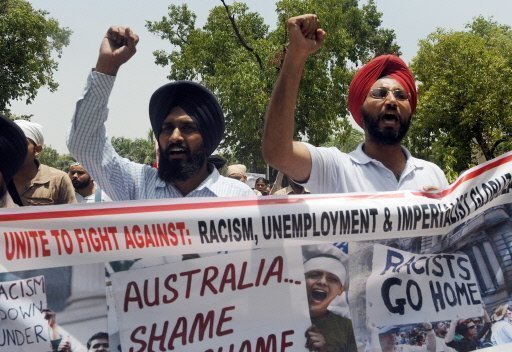 A Sikh exchange student from Punjab became the 20th victim, this year, of a hate crime in Australia. His attackers attempted to rip off his turban and forcibly cut his hair. According to the AFP, this is the latest in a wave of attacks against desis in Australia.
A Sikh exchange student from Punjab became the 20th victim, this year, of a hate crime in Australia. His attackers attempted to rip off his turban and forcibly cut his hair. According to the AFP, this is the latest in a wave of attacks against desis in Australia.
These attacks have been the subject of public protest, both among university students in Australia, and among others in India. Australia has been under pressure to address these hate crimes, and has been deploying police while claiming that these attacks are uncommon. The sheer number, however, indicate a wider tension between victims of racial hatred and violence, and their attackers. The last attack on a desi student, for example, has left the victim comatose. While the Australian government denies that these are racist attacks, the particular nature of these incidents seem to contradict this position. Does this spate of violence, then, expose the seemier underbelly of Australian race relations?
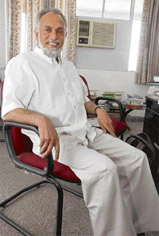 It is with saddness that we report on the passing of Ram Narayan Kumar, a human rights activist who actively and vocally worked on the dissapearances and killings in Punjab. He was 56 years old.
It is with saddness that we report on the passing of Ram Narayan Kumar, a human rights activist who actively and vocally worked on the dissapearances and killings in Punjab. He was 56 years old.
Kumar was a born human rights activist. He had engaged himself with human rights activism since 1975 when he was jailed for 19 months for protesting against the imposition of emergency. Though he belonged to Andhra Pradesh, his conscience dragged him to protest against the wide spread human rights violations in Punjab. There he co-founded Committee for Coordination on Disappearances in Punjab (CCDP) and co-authored a voluminous edition called ‘Reduced To Ashes’, a compilation of about 600 cases of human rights violations in the state. This report prompted the National Human Rights Commission to take cognizance of the large scale custodial disappearances and deaths in Punjab during that decade. [link]
In Terror in Punjab, Ram Narayan Kumar traces the roots of Sikh dissent in India that eventually culminated in the armed confrontation in 1984. Kumar also addresses the post-1984 period of Sikh militancy and the Indian state’s success in countering this militancy.
Kumar…documents and pays tribute to the Akali tradition of non-violence. He refers to the Akali Dal’s peaceful struggle for a Punjabi-speaking state, and makes an important point of historical value by highlighting that the Akali agitation of the 1980s for Punjab’s demands constituted “the largest non-violent movement in the sub-continent, including both the colonial and the independent periods, with over 150,000 volunteers courting arrest within a period of three years.” [link]
Ram Narayan Kumar worked extensively with several human rights organizations, including Ensaaf and his contributions to the field of human rights justice were invaluable. He played an important role in defending the rights of families who had been affected by the violence in Punjab. We will remember his work, his contributions and his value to the very important work being done for justice in Punjab.
